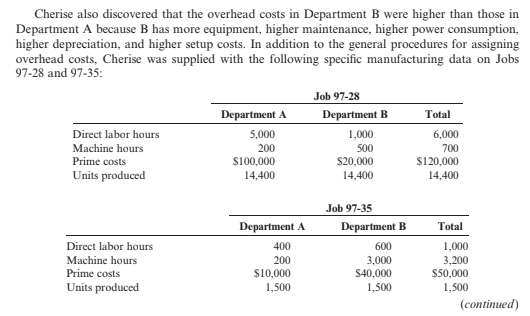Cherise also discovered that the overhead costs in Department B were higher than those in Department A because B has more equipment, higher maintenance, higher power consumption, higher depreciation, and higher setup costs. In addition to the general procedures for assigning overhead costs, Cherise was supplied with the following specific manufacturing data on Jobs 97-28 and 97-35: Job 97-28 Department A Department B Total Direct labor hours 5,000 1,000 6,000 Machine hours 200 500 700 Prime costs S100,000 $20,000 $120,000 Units produced 14,400 14,400 14,400 Job 97-35 Department A Department B Total Direct labor hours 400 600 1,000 Machine hours 200 3,000 3,200 $50,000 Prime costs S10,000 S40,000 Units produced 1,500 1,500 1,500 (соntinued)
Cherise Ortega, marketing manager for Romer Company, was puzzled by the outcome of two recent bids. The company’s policy was to bid 150 percent of the full
(labeled Job 97-28) had been turned down by a prospective customer, who had indicated that the proposed price was $3 per unit higher than the winning bid. A second job (Job 97-35) had been accepted by a customer, who was amazed that Romer could offer such favorable terms. This customer revealed that Romer’s price was $43 per unit lower than the next lowest bid.
Cherise has been informed that the company was more than competitive in terms of cost control. Accordingly, she began to suspect that the problem was related to cost assignment pro-
cedures. Upon investigating, Cherise was told that the company uses a plantwide
data. Selected budgeted data are given below.
Department A Department B Total
Overhead $500,000 $2,000,000 $2,500,000
Direct labor hours 200,000 50,000 250,000
Machine hours 20,000 120,000 140,000
Required:
1. Using a plantwide overhead rate based on direct labor hours, develop the bid prices for Jobs
97-28 and 97-35 (express the bid prices on a per-unit basis).
2. Using departmental overhead rates (use direct labor hours for Department A and machine
hours for Department B), develop per-unit bid prices for Jobs 97-28 and 97-35.
3. Compute the difference in gross profit that would have been earned had the company used
departmental rates in its bids instead of the plantwide rate.
4. Explain why the use of departmental rates in this case provides a more accurate product
cost.

Trending now
This is a popular solution!
Step by step
Solved in 4 steps









